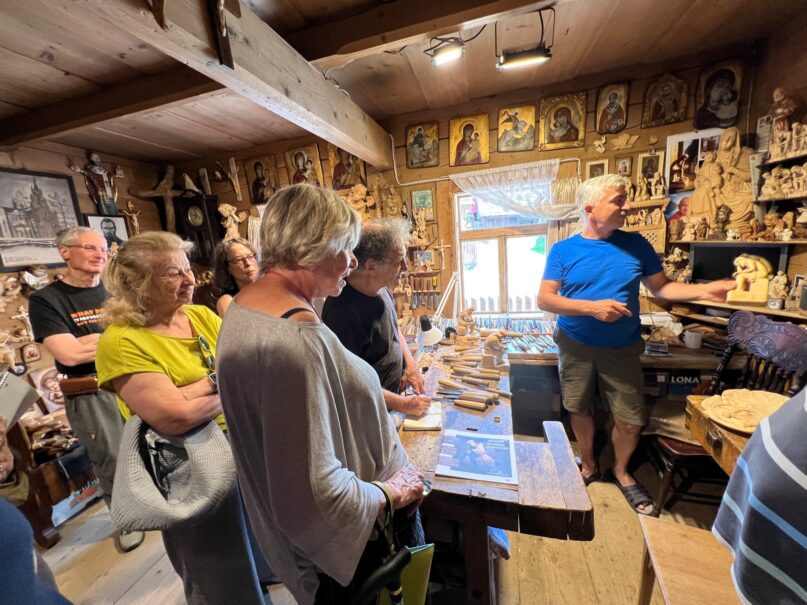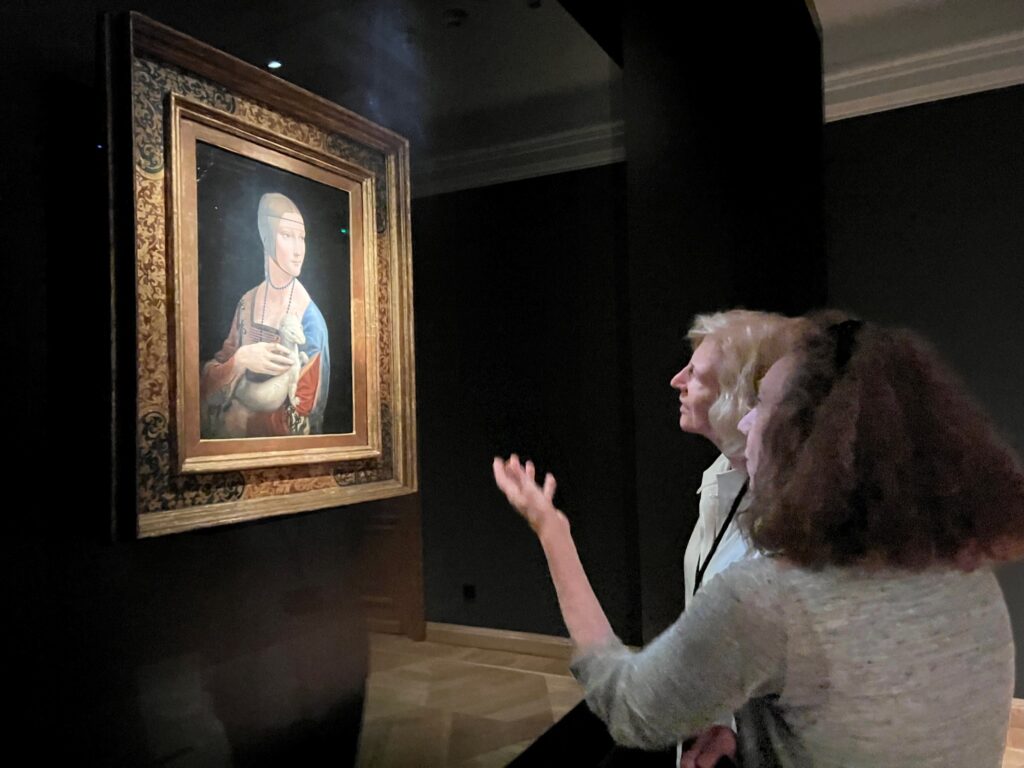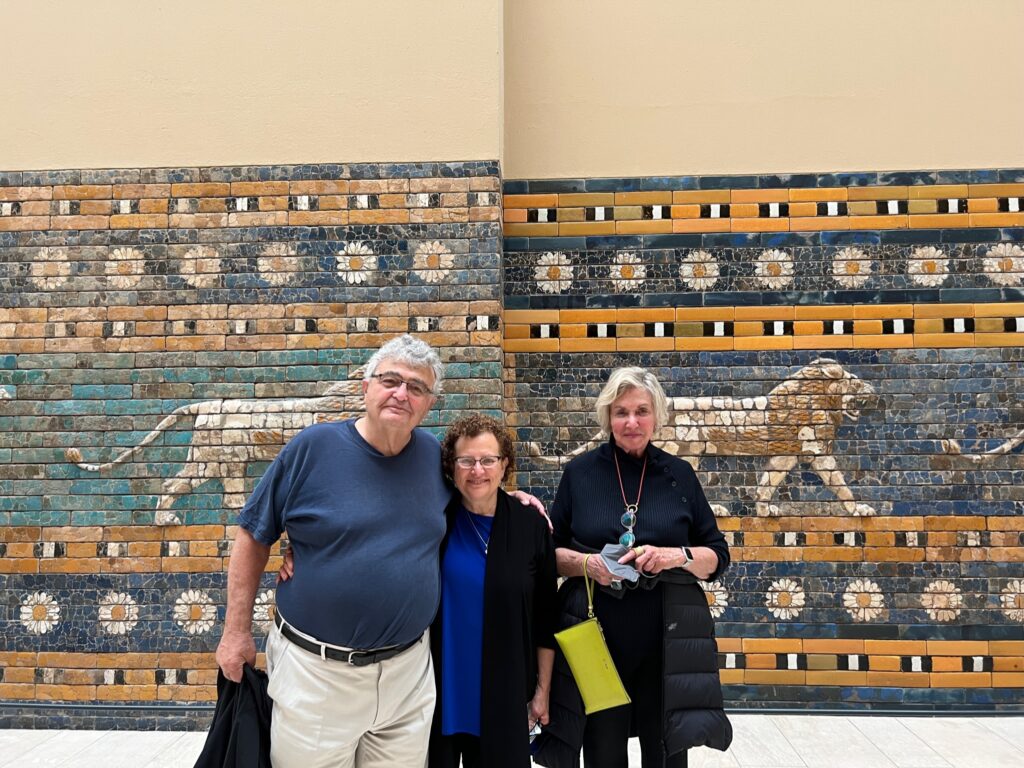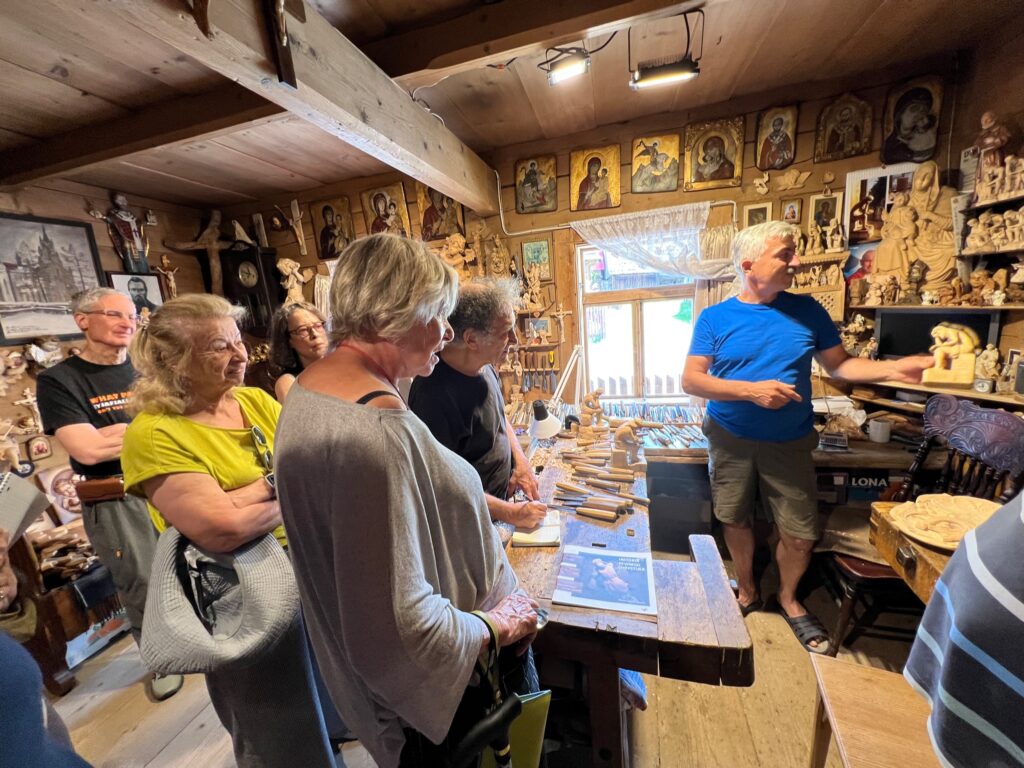
By Helen (Hinde) Martin Block
Since 2015, the YIVO Institute for Jewish Research has held annual study tours to various parts of Eastern and Central Europe, including Lithuania, Poland, Ukraine, and Jewish Galicia. Led by Connecticut resident Dr. Samuel Kassow, a noted historian of Ashkenazi Jewry, these study missions focus on understanding the Jewish experience in the context of the history and culture of the region.
The study tours resumed in 2022 after a two-year hiatus necessitated by the COVID pandemic. Owing to the war in Ukraine, however, the 2022 tours scheduled for Russia and Ukraine were cancelled and instead participants traveled to Krakow-Wroclaw-Berlin.
This year, Westport, Connecticut resident Helen Martin Block participated in the YIVO study tour. The following is a personal account of her experience. Block is the author of the acclaimed novel, The Shoemaker’s Daughter.
My first evening in Krakow, exhausted from travel, my suitcase in limbo between Warsaw’s Chopin and Krakow’s John Paul II airports, I am suddenly revived at the cantorial concert presented by the Krakow Jewish Cultural Festival. In the style to which I do not yet realize but will soon experience daily, we find our premium seats in the restored Tempel Synagogue. Yankel Lemmel, Yoel Kohn, Shimmy Miller and Jeremiah Lockwood, composer, organ, and piano player—four remarkable cantors from Brooklyn’s cantorial movement Golden Ages— perform. The four, and Krakow’s Aris String Quartet, rock the venue.
Highlights of the following days in Krakow are numerous. We meet the architect whose sparse and powerful memorial concept was selected to represent Kazimierz vacant of its Jews and their culture. He chose a series of metal chairs randomly placed on the cobble stone plaza where Jews had once been assembled for transport to death. Between June 1942 and March 1943, thousands of Jews were sent from Krakow Ghetto to their death in Belzec.
Prior to the study tour we were sent a reading list. I spot a plaque on a building wall in Kazimierz dedicated to one of the heroes from a book I read Justyna’s Narrative. The plaque is for Aharon (Dolek) Libeskind.
A quote from him reads: “From our path there is no turning back…. we are fighting for three lines in history, if only to show that Jewish youth did not go like sheep to the slaughter.”
Beneath the quote it tells that in November 1942 he was one of the leaders of the underground movement “The Fighting Pioneers” and commander of the uprising. The height of their resistance activities against the Nazis took place on the night of Dec. 22, 1942, whence tens of Germans were killed and wounded. Most of the fighters were captured and murdered. The last line on the plaque reads: ”They deserve much more than three lines in history.”
And so, the experiences go. From respect, to anguish, awe, enjoyment, pride, hope — an emotional roller coaster ride while bonds evolve among the group.
On a Friday evening we meet in the lobby of the fashionable Stary Hotel and walk to Shabbat dinner at the JCC. We are seated, little challahs wrapped in napkins at our place settings. We sit among over 500 people, all ages, the majority young! The theme is “Shabbat Shalom Building a Jewish Future in Krakow.”
On Saturday at the Krakow JCC, we are delighted to witness the debate: Latkes vs Hamantaschen. My son in Brooklyn, New York, for whom I have dutifully left the itinerary, texts me. He and his friend are taking opposing points of view; he for latkes, his friend for Hamantaschen. The debate has become an international event. In the same building, as we leave sampling the delicacies that were the subjects of debate, we witness Ukrainian refuges picking up food and supplies.
The days and learning progress. We visit Schindler’s Museum. One of my relatives, Willie Sterner, worked as Oskar Schindler’s painter in the enamelware factory. Before we go inside the museum, I am compelled to say a few words to my fellow tour particpants: Sam Kassow renowned historian and lecturer; his wife Lisa, a recently retired college administrator; Irene, YIVO vice chair; Shelly, YIVO chief of staff; Judith, a recently retired doctor; her husband Michael, an oncologist; Ella, a researcher, scientist and writer; Victor, her charming son, a business consultant; Arnold, a well-known Australian author; Sym, an attorney; his wife Lily, a retired French instructor; and Dariusz, our stalwart, caring, gregarious guide.
Personal feelings well up as I walk through the museum crowded with historical information, telling the history prior to and during World War II. The story of Poland and its enemy Germany is illustrated graphically. The movie Schindler’s List comes to mind, yet the museum tells a broader in-depth version from many other perspectives. I stop at a display of children’s toys and peer at three dolls. One is an exact replica of a doll I had when I was a little girl living in a DP camp in Germany. I imagine she is made of material created by a German chemical conglomerate. For their war efforts. She is plastic with molded blond hair. The joints in the doll’s arms and legs are fixed, unbending. The same dark blue hard plastic eyes stare from the showcase. Memories and images of ‘Susie,’ the doll I gave an American name after we immigrated, move me to reveries of long ago.
On Tuesday, July 5, the fifth day of our tour, we arrive in Czestochowa. We stand in an overgrown desolate field, clouds above and in front of us a long rectangular brick monument dedicated to Jews who once lived here. On its far side is affixed a large brass Magen David, to which someone has hung a yellow ribbon. Clarity and emotion envelop me. Why I am on this study tour is in full focus.

Sam begins his lecture and, as we pay attention, some eyes cannot help shifting to a long grey plastic silhouette wall. It depicts men and women marching to where – they do not know. Sam’s intermittent talks are an integral part of the YIVO menu, curated to include learning, music, theater, stirring images, scholarly events, museums, first class accommodations, world famous UNESCO sites, lectures, festive meals, and guides to enlighten us wherever we travel. All this unfolding to a group of individuals each on his or her own quest.
Rooted to this field in Poland, the country of my parents’ birth, where they suffered tragedies and yet were sheltered from death by good Polish people, I resolve to move forward on a project I have hidden from for too long. In the field in Czestochowa, I fight tears. I lower my eyes and read the English translation on a bronze tablet in front of the long brick monument.
SEPTEMBER 22 -OCTOBER 7 1942 GERMAN NAZIS OCCUPANTS DEPORTED FROM THIS PLACE
40,000 JEWS OF CZTOCHOWA
TO THEIR DEATH IN TREBLINKA GAS CHAMBERS THEIR MEMORY BE HONORED
The impact of this site is compounded by a man I knew in a city in upstate New York where I grew up. He was a ‘lucky’ one who had worked in the forced labor camp munitions factory, HASAG-Pelcery in Czestochowa. David had lived with us. I had heard his stories. But I did not understand, until Sam stands in front of the brick wall and talks about HASAG and, like a true professor, he awakens my need to learn more.
As if this experience has not touched me deep enough, we meet our guide and soon descend into the secret bunker literally beneath our feet on the street. I watch the faces of my fellow travelers as we stand huddled in a small dark place, surrounded by raw stone walls where 27 people lived for about a month; where even enough oxygen to breathe, let alone enough food are in short supply, and the prospect of being discovered looms each moment. Yes, they were discovered. Here, for the first time in my life, I have a brief time in such a place, a hidden bunker. My parents had lived in a bunker, a cramped potato cellar with dirt walls for almost two years.
And yet, to balance all we have experienced, in the evening we take a cruise on the Odra River. A cool breeze, the bridges we navigate beneath, the passing ancient or restored buildings, the setting sun shimmering on the calm water and our stunning Polish lady guide makes us feel so, so alive.
In Wroclaw we meet world famous scholar Marcin Wodzinski whose intellect, crane-like stature and prominent silver eyebrows mesmerize us. We walk to Wroclaw University a world- famous beacon of intellectual excellence. Like most buildings in Wroclaw, it too had been destroyed, but now is rebuilt and preserved wherever possible. In the sparse lunchroom, we meet a group of young scholars from around the globe. Opposite me sits a young woman from Harvard. I meet a young man from the University of Pennsylvania. Like my fellow travelers, I am entranced by this lucky happenstance. In the evening we are guests at The White Stork Synagogue, where Bente Kahan sings, plays the piano, performs brilliantly in concert with dramatic readings from our own – Arnold Zable.
More, more there is so much more. We leave Poland on our way to Germany with a stop in Dresden, and then arrive in Berlin to check in at the elegant Adlon Kempinsky Hotel, steps from the Brandenburg Gate. On the days that follow, we walk through the rooms where the Wannsee Conference was held. Where the plan to annihilate millions of Jews and many other humans considered inferior beings was conceived. We walk through artist Max Liebermann’s opulent gardens and are riveted by his work.

The next to last night, dressed in our best, we arrive at the Komische Opera Berlin. This is the final performance of Barrie Kosky’s All-Singing All-Dancing Yiddish Review. We are greeted by champagne carrying waiters offering their trays to the theater goers. Hundreds of Berliners have come to the show and to wish Barrie Kosky farewell for his 12-yea residency as director. Of course, Irene who has orchestrated so much, introduces Barrie to us! And then we take our seats, orchestra row two.
To the unique group of people I met, a few that I feel are kindred spirit friends, I say, I hope we meet again soon. I will remember you all.
The YIVO Institute for Jewish Research is dedicated to the preservation and study of the history and culture of East European Jewry worldwide. For nearly a century, YIVO has pioneered new forms of Jewish scholarship, research, education, and cultural expression. The YIVO Archives contains more than 23 million unique items and YIVO’s Library has over 400,000 volumes—the single largest resource for such study in the world. yivo.org / yivo.org/the-whole-story.







 Southern New England Jewish Ledger
Southern New England Jewish Ledger
















